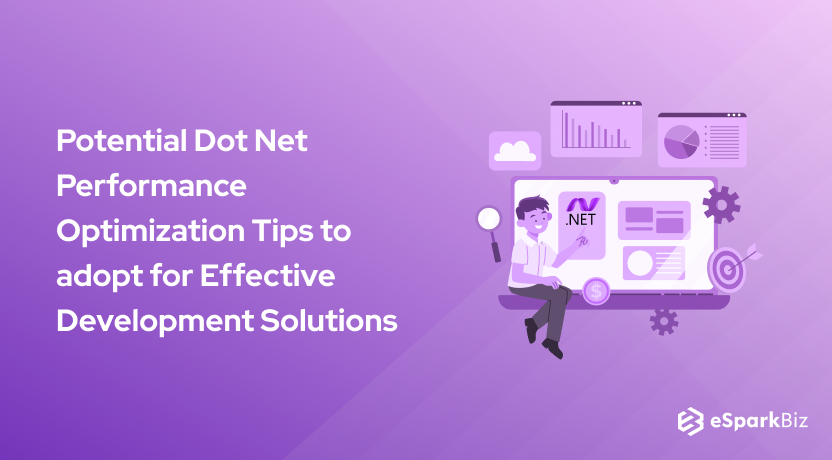When developing a website or application, the developer’s priority is always the application’s performance. This is primarily because today’s technology-savvy end users require programs that give exceptional user experiences while operating rapidly.
Asp.Net, a feature-rich application development platform, makes building scalable and reliable apps possible. Although Asp.Net applications usually run at the highest level, it doesn’t imply there isn’t potential for improvement.
Then our concern is how to improve .Net application performance. Any application’s performance and speed can constantly be improved with a few minor adjustments, and these modifications can produce some fantastic outcomes.
Adhere to the Vital Dot Net Performance Optimization Tips

User satisfaction is closely correlated with speed, even when using internal apps. Therefore, when developing an Asp.Net application, performance is one of the most crucial factors to consider.
Let’s look at the Dot Net performance optimization tips to tune your web application.
Using .Net Profiler: Easy Bug Detection
A developer’s best friend in improving application speed is a .Net profiler. When performing low-level CPU and memory optimizations, they are essential.
The .Net CLR profiling interface is how a typical .Net profiler operates. This enables low-level profiling of the .Net MSIL bytecode to comprehend each operation your code executes. To see which methods in your code are consuming the most CPU, they can use this to show you the “hot path” within it.
Using Asynchronous Calls: Achieving Quick & Responsive Client-side Rendering
When creating Asp.Net applications, try to stay away from synchronous calling. Asynchronously execute the call when calling an API, executing I/O operations, or doing independent calling. The subsequent execution is delayed while the present execution is ongoing due to synchronous calling.
Slow response times and Thread Pool starvation can be caused by blocking synchronous calls. Using asynchronous APIs, processing hundreds of requests simultaneously without waiting for blocking calls to finish is possible. The thread might pay attention to a different request instead of waiting for a lengthy synchronous operation to complete.
Caching Utilization: Essential for Dynamic Page Loading
Caching is one of the most effective and widely used methods in .Net performance optimization. You should actively cache any data for a reasonable amount of time. Both web pages and database-retrieved data can be cached. Response caching can be used to save the output.
The ability to cache web server responses using cache-related headers in HTTP response objects is called response caching. Asp.Net Core has response caching middleware, which can be used to enable response caching.
Inline SVG & CSS: Enhanced Image Rendering
Programmers can write code at the exact location due to a feature of C# called inline methods. The performance of Asp.Net Core can be enhanced using inline methods. Inline methods, as opposed to ordinary methods, do not incur an overhead in terms of memory allocation, maintaining method call information in the memory, etc., which helps them run better.
Inline methods increase efficiency by eliminating the requirement for sending arguments and saving and restoring registers. It should be noted that the JIT (just-in-time) compiler will not inline a method with a throw statement. However, programmers can utilize a static helper method and incorporate the throw declaration.
JSON Serialization: Achieving High-performance
System.Text.Json is the default JSON serialization library used by Asp.Net Core 3.0. JSON can now be read and written asynchronously. Performance is improved more by this than by Newtonsoft.Json. The following capabilities are available for processing JSON through the System.Text.Json namespace:
- Low allocation
- High performance
- Standards-compliant features
HTTP Compression: Enhancing Transmission Time
The content is not typically compressed while using the HTTP protocol because it is not a particularly effective protocol. Although HTML, CSS, and JavaScript are usually delivered as text, some web resources, mainly photos, are already compressed.
The gzip technique can be used to compress HTTP content in even the oldest of browsers. An HTML file that uses gzip compression will save roughly two-thirds of its original size. For example, a 100kb uncompressed file will only transmit as 33kb. This save is fantastic!
You can use either of the two compressions mentioned below,
- Static Compression: It operates by compressing static cache content. The request uses a compressed version.
- Dynamic Compression: Here content is constantly changing. Without adding to the cache, it supports compression.
String Handling: Improving Application Memory
Programmers frequently need to alter Strings, which may involve adding or creating new Strings. One of the main performance bottlenecks for an application is ineffective String handling.
A String is an effective way to handle the memory of your application.
Here are the tips for using String:
- To get quick output, use response.write().
- Use String Builder
- To concentrate String use += operator
- To compare two Strings, use String. compare; don’t use .Tolower().
Avoid Throwing Unnecessary Exceptions: Handling Errors Effectively
Exceptions harm performance. Exception throwing and catching are terrible for an application’s performance and should be avoided at all costs or used in extreme circumstances. Developers should avoid exception handling to convey logic flow in their programs and utilize exceptions sparingly.
Client Side Improvements: Achieving High-performing App
Among the crucial components of performance improvement is client-side optimization. The following Dot Net performance optimization tips should be kept in mind when using Asp.Net Core to create a website:
- Bundling: It reduces the number of server queries by combining multiple files into one. A webpage can include numerous separate bundles.
- Minification: It reduces file size by removing extraneous characters from code without affecting functionality. After minification, variable names are reduced to one character, and comments and extra spaces are eliminated.
- Loading JavaScript at last: JavaScript files should be loaded last. Users won’t have to wait if you do that because static material will load more quickly.
- Use a Content Delivery Network: To load static files like photos, JS, CSS, etc., use a content delivery network (CDN). Delivering information from the closest local server keeps your data nearby to your customers.
Also Read – What’s New in .NET 7
Resource Management: Optimizing Resource Load
The performance of your application depends on the resources you use. If the resource management is poor, it will provide an unnecessary load to the CPU.
Following are the tips for best resource management:
- Use connection objects properly
- Effectively use pooling
- Handle memory leaks wisely
- Clear unused variables
- Remove unused resources
Conclusion
If you worry about how to improve .Net application performance, then it is smartly achieved by following a few best .net practices. The importance of these tasks is determined by your needs, available time and resources, and so on. Programmers should also benchmark application performance to see how well the program performs after optimization.
These Dot Net performance Optimization tips should help you improve the performance of your website and, hopefully, make your users extremely pleased. If you are unaware of how to enhance the .Net application, you should hire .Net developers to take responsibility for every significant task.
Why is eSparkBiz the one-stop solution for your .Net performance optimization?
To provide complete Asp.Net web solutions, eSparkBiz uses high-quality, industry-standard practices. As a result, they have gained the trust of their pleased clientele with verified results.
eSparkBiz provides cutting-edge, specialized .Net web solutions as part of their traditional full-cycle Asp.Net development services. The company also provides dynamic CRM, CMS, third-party integration, MVC3/MVC4/MVC5 development, SharePoint sites, eCommerce shopping carts, database apps, and online services for PCs and smartphones as the top.Net development company.


-
Is Asp.Net secure?
Yes, Microsoft supports Asp.Net and regularly releases security updates and patches for the framework. Working with Asp.Net is entirely safe because your application data will be protected by its security measures.
-
What is the development cost of the Asp.Net application?
Asp.Net apps can be produced for various prices depending on the features and other associated functionalities.
-
How to hire a .Net developer?
By comparing companies to one another and choosing the ones that best suit your demands, you can hire dedicated .Net developers and companies. A trusted company like eSparkBiz can be a good choice to outsource your .Net projects or hire .Net developers within budget.
-
What are the components of .Net?
- Common language run-time
- Common type system
- Net class library
- Application domain
- .Net framework
- Profiling












